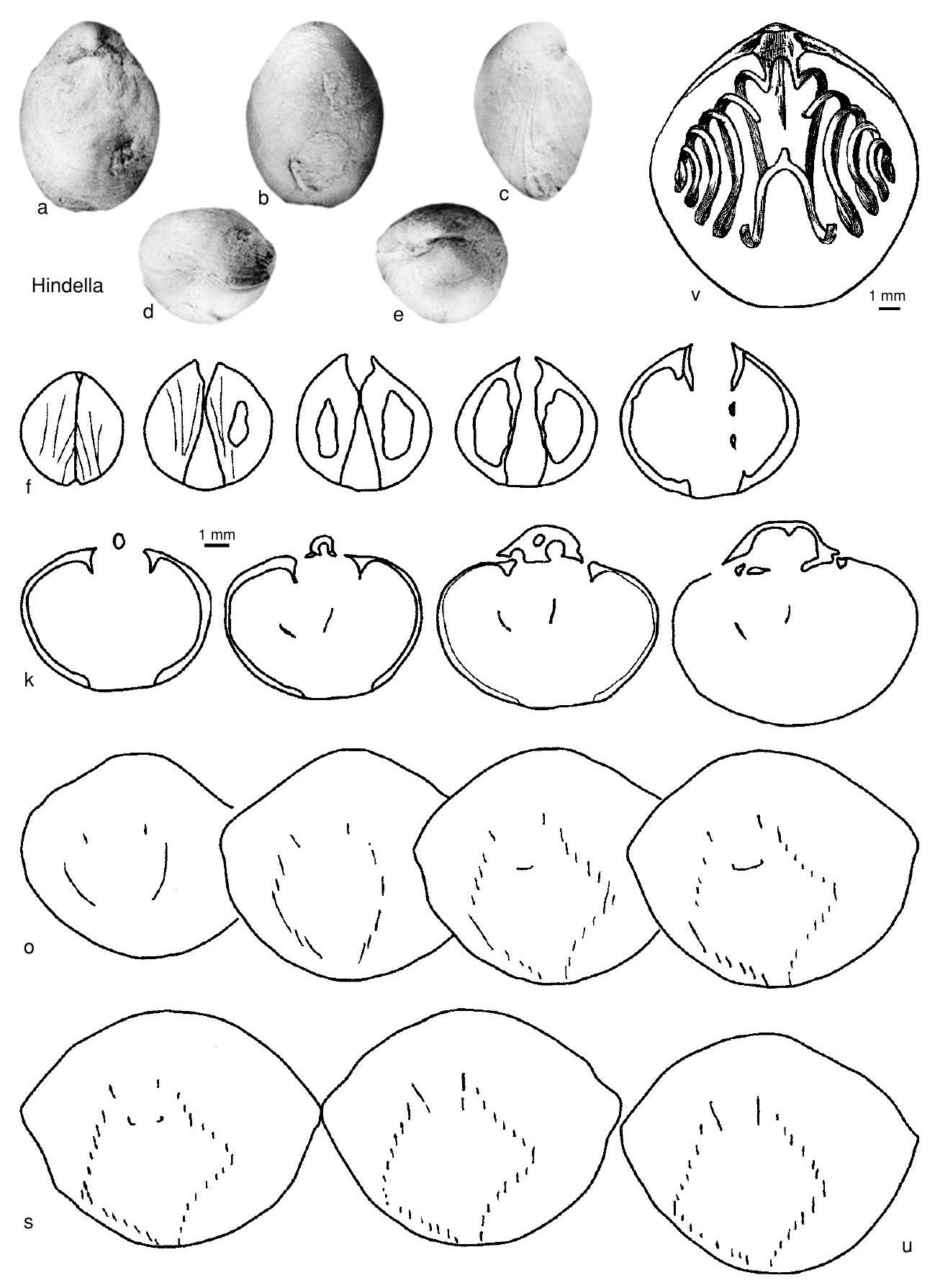Welcome to the Treatise on Invertebrate Paleontology!
Please enter a genera name to retrieve more information.

Hindella
Classification
Phylum:
Brachiopoda
Subphylum:
Rhynchonelliformea
Class:
Rhynchonellata
Order:
Athyridida
Suborder:
Athyrididina
Superfamily:
Meristelloidea
Family:
Meristellidae
Subfamily:
Meristellinae
Formal Genus Name and Reference:
Hindella DAVIDSON, 1882, p. 130
Type Species:
Athyris umbonata BILLINGS, 1862, p. 144, OD
Images
(Click to enlarge in a new window)
Fig. 1063a-v. *H. umbonata (Billings), Ashgill, Anticosti Island, Canada, a-e, dorsal, ventral, lateral, anterior, and posterior views, USNM 497418, x1.5 (new), f-u, transverse serial sections 0.8, 1.1, 1.5, 1.7, 2.1, 2.9, 3.1, 3.4, 4.0, 4.4, 5.9, 6.6, 7.1, 7.4, 7.9, 8.0 ~mm from ventral umbo, BMNH BB94780 (new), v, dorsal valve interior and brachidium (Glass in Davidson, 1882).
Synonyms
Cryptothyrella
Geographic Distribution
North America, Peru, Venezuela, Argentina, Sweden, Norway, Estonia, United Kingdom, Ireland, Czech Republic, southern Alps, Sardinia, Turkey, Altay-Sayan, Kazakhstan, Tuva, ?Thailand, southern and western China (Tibet), Burma
Age Range
Beginning Stage in Treatise Usage:
Upper Ordovician (Ashgill)
Beginning International Stage:
Katian
Fraction Up In Beginning Stage:
66.7
Beginning Date:
447.72
Ending Stage in Treatise Usage:
Silurian (Llandovery)
Ending International Stage:
Telychian
Fraction Up In Ending Stage:
100
Ending Date:
432.93
Description
Medium to large, elongate, subequally to ventribiconvex shells of variable outline commonly ranging from subrectangular to pyriform, ventral beak strongly incurved, dorsal fold and ventral sulcus absent or poorly developed, less frequently with narrow and shallow sulcus extending from umbo of ventral valve, and from about one-third posterior length of dorsal valve to anterior margin, few but strong growth lines, long, medially convex or dorsally convergent dental plates bounding deeply impressed muscle field, narrow, deep, and partially covered septalium, sessile or supported by median septum extending quite anteriorly as low ridge, lateral branches of jugum commonly originate well anteriorly, projecting backward at low angle, semicircular jugal arch projecting posteriorly as short, straight, and undivided stem, tertiary layer may be present.
References
Museum or Author Information
Classification
Phylum:
Brachiopoda
Subphylum:
Rhynchonelliformea
Class:
Rhynchonellata
Order:
Athyridida
Suborder:
Athyrididina
Superfamily:
Meristelloidea
Family:
Meristellidae
Subfamily:
Meristellinae
Formal Genus Name and Reference:
Hindella DAVIDSON, 1882, p. 130
Type Species:
Athyris umbonata BILLINGS, 1862, p. 144, OD
Images
(Click to enlarge in a new window)
Fig. 1063a-v. *H. umbonata (Billings), Ashgill, Anticosti Island, Canada, a-e, dorsal, ventral, lateral, anterior, and posterior views, USNM 497418, x1.5 (new), f-u, transverse serial sections 0.8, 1.1, 1.5, 1.7, 2.1, 2.9, 3.1, 3.4, 4.0, 4.4, 5.9, 6.6, 7.1, 7.4, 7.9, 8.0 ~mm from ventral umbo, BMNH BB94780 (new), v, dorsal valve interior and brachidium (Glass in Davidson, 1882).
Synonyms
Cryptothyrella
Geographic Distribution
North America, Peru, Venezuela, Argentina, Sweden, Norway, Estonia, United Kingdom, Ireland, Czech Republic, southern Alps, Sardinia, Turkey, Altay-Sayan, Kazakhstan, Tuva, ?Thailand, southern and western China (Tibet), Burma
Age Range
Beginning Stage in Treatise Usage:
Upper Ordovician (Ashgill)
Beginning International Stage:
Katian
Fraction Up In Beginning Stage:
66.7
Beginning Date:
447.72
Ending Stage in Treatise Usage:
Silurian (Llandovery)
Ending International Stage:
Telychian
Fraction Up In Ending Stage:
100
Ending Date:
432.93
Description
Medium to large, elongate, subequally to ventribiconvex shells of variable outline commonly ranging from subrectangular to pyriform, ventral beak strongly incurved, dorsal fold and ventral sulcus absent or poorly developed, less frequently with narrow and shallow sulcus extending from umbo of ventral valve, and from about one-third posterior length of dorsal valve to anterior margin, few but strong growth lines, long, medially convex or dorsally convergent dental plates bounding deeply impressed muscle field, narrow, deep, and partially covered septalium, sessile or supported by median septum extending quite anteriorly as low ridge, lateral branches of jugum commonly originate well anteriorly, projecting backward at low angle, semicircular jugal arch projecting posteriorly as short, straight, and undivided stem, tertiary layer may be present.
